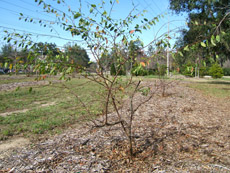Prunus umbellata (Flatwoods Plum)

*Click on picture for more images of this species.
- USDA Hardiness Zone: 8A - 9B
- Mature Height: 12 to 20 ft
- Mature Spread: 12 to 20 ft
- Growth Rate: Moderate
- Availability: Somewhat available
- Drought Tolerance: Moderate
- Salt Tolerance: Poor
- Light Requirements: Full sun to partial sun.
- Native Origin: Native to Florida.
- Soil Drainage: Needs a well-drained site.
- Foliage: Deciduous tree with no showy fall color.
- Flowers: White, showy flowers in the winter and spring.
- Pests: No pests or disease of major concern, but tent caterpillars can infest Flatwoods Plum.
Description: A native of the woods of the southeastern United States, Flatwoods Plum is a round-topped, deciduous tree, reaching 20 feet in height with a 15-foot spread, which is most often planted for its spectacular display of blooms. It may look a little ragged in winter. In late February, before the two-inch-long, finely serrate leaves appear, these small trees take on a white, billowy, almost cloud-like appearance when they are clothed in the profuse, small, white flower clusters. These half-inch blooms are followed by one-inch-long, edible, purple fruits which vary in flavor from very tart to sweet. These plums are very attractive to various forms of wildlife.
Flatwoods Plum thrives in full sun or partial shade on a wide variety of soils. When placed in sandy soil, it grows best with irrigation and some shade in the afternoon. Trees grow quickly when young but considerably slower when mature and bearing fruit. A bit weedy in growth habit, proper training and pruning can create an attractive specimen or small median strip or street tree, especially for planting beneath power lines or in other areas were overhead space is limited. Few root suckers form on this plant. Do not expect a row of them to form a uniform shape.
The tree branches low to the ground making it a nice tall element in a backyard shrub border. Lower branches need to be removed in order to train as a street tree. Small-diameter, interior branches can be removed in winter to open up the crown for a more formal, attractive shape and habit. It may live 30 to 40-years on a good site.
Gainesville Observations: This tree should be suited for planting near power lines. Tent caterpillars have been common on our trees. Although trees recover by growing a new set of foliage following caterpillar defoliation they are a mess when infested. Flowers have been reliable and beautiful in early to mid March. Our trees came with a short trunk (about 3 feet tall) which makes pruning to a dominant leader difficult but possible. Low branches droop toward the ground and require pruning for clearance under the canopy. Could be used as a street tree if trained to a central trunk.

